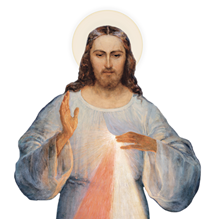
By Chris Sparks
I was talking to a friend mid-college who was interested in learning more about the Catholic faith. We were discussing sacramentals. I said how sad it was that so many Catholics know nothing of these means of opening the door to God's grace in their lives, and imagine what would happen if we said yes to God's action in our lives in as many ways as we can! If each of the sacramentals allows at least a trickle of grace, imagine what would happen if we opened the door to God through as many avenues as possible!
My friend has since taken to wearing a great quantity of medals on a regular basis.
Now, why do we use these medals, ribbons, scapulars, blessed and/or exorcised salt, oil, or water, and so many other blessed bits and bobs of matter in our prayers or devotions? Why does God care?
Because He's the source of all grace, and He's also the Creator of all matter. He chooses to work through matter, to mediate our natural life to us through food, water, air, and earth. He chooses to mediate supernatural life to us through the Sacraments: through the waters of Baptism, the bread and wine that is transubstantiated into the Eucharist, and the oils of Baptism, Confirmation, Ordination, and Anointing of the Sick.
Further, He chooses to allow sacramentals, such as the bones of a saint, the objects touched by a saint, or objects that He or a messenger from Heaven has instructed the faithful to use in a devotional way, to mediate grace. When a dead man fell on the bones of Elisha, he rose from the dead (see 2 Kgs 13:21). When cloths touched to St. Paul were applied to the sick and the possessed, the sick were cured and evil spirits cast out (see Acts 19:11-12). When the Levites bearing the Ark of the Covenant, created at the direct command of God, stepped into the River Jordan, it stopped in its flow (see Josh 3), among a whole host of other mighty miracles connected with the Ark.
So the legacy of sacramentals in the devotional life of the Church comes from a very long Scriptural tradition, indeed. And one of the greatest of the sacramentals is the Brown Scapular of Our Lady of Mount Carmel. As Fr. Michael Gaitley, MIC, explains in 33 Days to Morning Glory:
The brown scapular, also known as the Scapular of Our Lady of Mount Carmel, is the most popular devotional scapular. Its popularity stems in large part from the famous apparition of Mary to St. Simon Stock, an English Carmelite, who lived during the mid-thirteenth century.
In the apparition, Mary reportedly held in her hands the brown habit of the Carmelite Order, offered it to St. Simon, and said, "This will be for you and for all Carmelites the privilege, that he who dies in this habit will be saved." The key words are these: "he who dies in this habit will be saved." ...
[T]he brown scapular is also worn by members of the Confraternity of the Brown Scapular. A confraternity is a group of people united by a common profession or purpose, and it is typically a religious group joined by a common spirituality and cooperation in certain good works. The scapular community members strive for the perfection of charity according to the spirit of the Carmelite Order and thereby participate in its spiritual benefits, such as the promise of Our Lady to St. Simon regarding Carmelites.
It should be noted that one can be enrolled in the rite of the brown scapular without joining a confraternity. In 1996, in a statement approved by the Congregation for Divine Worship and the Discipline of the Sacraments, the Church declared that whoever receives the brown scapular becomes a member of the Carmelite Order and pledges oneself to live its spirituality in accordance with one's state in life.
So, all Carmelites are free to believe in the promise made by Our Lady to St. Simon regarding them. However, they need to strive to be faithful to the demands of charity and the way of perfection. In other words, the brown scapular is not a good-luck charm or superstitious "free pass to heaven." Rather, it is a sign of a serious commitment to live an ardent Christian life under the patronage and protection of Our Lady of Mt. Carmel, whose powerful intercession sees to it that her true sons and daughters will be saved.
The Brown Scapular invites the Lord to pour out tremendous graces on those who wear it faithfully and live the spirituality it signifies. And Our Lady has made it clear that she thinks the Brown Scapular is important for those of us living today. On Oct. 13, 1917, in the course of the Miracle of the Sun, Our Lady appeared to the three shepherd children at Fatima in Portugal as Our Lady of Mount Carmel.
The Church celebrates the feast of Our Lady of Mount Carmel on July 16. Let us turn to her for her intercession for us and all those whom we love, asking that the Lord's loving will be done and that we use all the graces He offers us in the best way possible, bearing fruit that will last by our own salvation and sanctification, as well as the blessings we bring to others. Let us become enrolled in the Brown Scapular, enroll all those in our spiritual care, such as children and godchildren, if at all possible, and open the doors to God's action as widely as we possibly can.
To learn more about the Brown Scapular, see our pamphlet "Graces Offered by the Brown Scapular" (Product Code GOBS). To order Brown Scapulars (Product Code BRS), go here.
If you have consecrated to Jesus through Mary or completed the Consoling the Heart of Jesus retreat, we'd love to hear your story. Please take a moment and share your journey below. If you have pictures, we'd love to see them, too. Just email them to HAPP@Marian.org!
{shopmercy-ad}

















